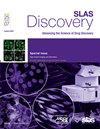New homocysteine consumption assay for high-throughput screening of human cystathionine-β-synthase
IF 2.7
4区 生物学
Q2 BIOCHEMICAL RESEARCH METHODS
引用次数: 0
Abstract
Hyperhomocysteinemia is a risk factor for cardiovascular disease, neurological disorders, and bone abnormalities. The key enzyme in homocysteine metabolism, cystathionine-β-synthase (CBS) is recognized as a target for new homocysteine-lowering therapies including enzyme replacement and gene therapy. Currently, there are no pharmacotherapies available that enhance CBS activity through its allosteric mechanism. The only known allosteric activator of CBS is S-adenosyl-L-methionine (SAM), which is available as a food supplement, but its effectiveness is limited by low membrane permeability and universal involvement in methylation reactions as a substrate. The discovery of CBS activators in high-throughput screening is challenging due to a lack of dedicated assays. Available HTS-compatible activity assays for CBS rely on measuring the product hydrogen sulfide or methanethiol where the signal increases with increased CBS activity. In the case of fluorescence-based assays, it is challenging to discern activators from autofluorescent compounds.
In this study, we introduce a homocysteine consumption assay for isolated human CBS (HconCBS) based on the absorbance of Ellman's reagent. This assay leverages a decrease in signal upon CBS activation, with performance parameters exceeding the requirements for high-throughput screening. In a commercial library of 3010 compounds, the HconCBS assay identified 10 hit compounds as more active than SAM, whereas a fluorescence-based assay using 7-azido-4-methylcoumarin (AzMC) identified 141 hits. HconCBS identified 101 compounds with autoabsorbance which did not include hit compounds, while the fluorescence-based assay identified 383 autofluorescent compounds which included all hit compounds. While 4 out of 10 HconCBS hits were confirmed when purchased from a new source, the compounds affected homocysteine rather than CBS. Nevertheless, HconCBS consistently detected the CBS activator seleno-adenosyl-L-methionine (SeAM) added to 4 library plates and re-discovered the same library hits in 3 out of 4 re-screened plates.
Taken together, HconCBS was designed to enable the discovery of allosteric CBS activators with greater reliability than fluorescence-based methods. Despite identifying some compounds that acted on homocysteine rather than CBS, the assay consistently identified the CBS activators SAM and SeAM and demonstrated reproducibility across two screening rounds. These findings establish HconCBS as a valuable tool for identifying potential therapeutic candidates for hyperhomocysteinemia, addressing a key gap in the development of CBS-targeted pharmacotherapies.

高通量筛选人半胱甘氨酸-β-合成酶的新同型半胱氨酸消耗测定
高同型半胱氨酸血症是心血管疾病、神经系统疾病和骨骼异常的危险因素。胱硫氨酸-β-合成酶(CBS)是同型半胱氨酸代谢的关键酶,被认为是酶替代和基因治疗等新型同型半胱氨酸降低疗法的靶点。目前,尚无药物疗法可通过其变构机制增强CBS活性。唯一已知的CBS变构激活剂是s -腺苷- l-蛋氨酸(SAM),可作为食品补充剂,但其有效性受到低膜通透性和作为底物普遍参与甲基化反应的限制。由于缺乏专门的检测方法,在高通量筛选中发现CBS激活剂具有挑战性。可用于CBS的高温高温相容活性分析依赖于测量产物硫化氢或甲硫醇,其中信号随着CBS活性的增加而增加。在基于荧光分析的情况下,从自荧光化合物中辨别激活剂是具有挑战性的。在这项研究中,我们介绍了一种基于Ellman试剂吸光度的人分离CBS (HconCBS)的同型半胱氨酸消耗测定方法。该分析利用CBS激活时信号的减少,其性能参数超过了高通量筛选的要求。在一个包含3010个化合物的商业文库中,HconCBS法鉴定出10个命中的化合物比SAM更有活性,而使用7-叠氮-4-甲基香豆素(AzMC)的荧光法鉴定出141个命中。HconCBS鉴定出101种具有自吸光度的化合物,其中不包括命中化合物,而基于荧光的测定鉴定出383种具有自吸光度的化合物,其中包括所有命中化合物。虽然从新来源购买时,10个HconCBS中有4个被证实,但这些化合物影响的是同型半胱氨酸,而不是CBS。然而,HconCBS一致地检测到添加到4个文库板中的CBS激活剂硒腺苷- l-蛋氨酸(SeAM),并且在4个重新筛选的板中的3个重新发现了相同的文库点。综上所述,HconCBS被设计为能够比基于荧光的方法更可靠地发现变弹性CBS激活剂。尽管发现了一些作用于同型半胱氨酸而不是CBS的化合物,但该试验一致地确定了CBS的激活剂SAM和SeAM,并在两轮筛选中证明了可重复性。这些发现确立了HconCBS作为确定高同型半胱氨酸血症潜在治疗候选药物的有价值工具,解决了开发以cbs为目标的药物治疗的关键空白。
本文章由计算机程序翻译,如有差异,请以英文原文为准。
求助全文
约1分钟内获得全文
求助全文
来源期刊

SLAS Discovery
Chemistry-Analytical Chemistry
CiteScore
7.00
自引率
3.20%
发文量
58
审稿时长
39 days
期刊介绍:
Advancing Life Sciences R&D: SLAS Discovery reports how scientists develop and utilize novel technologies and/or approaches to provide and characterize chemical and biological tools to understand and treat human disease.
SLAS Discovery is a peer-reviewed journal that publishes scientific reports that enable and improve target validation, evaluate current drug discovery technologies, provide novel research tools, and incorporate research approaches that enhance depth of knowledge and drug discovery success.
SLAS Discovery emphasizes scientific and technical advances in target identification/validation (including chemical probes, RNA silencing, gene editing technologies); biomarker discovery; assay development; virtual, medium- or high-throughput screening (biochemical and biological, biophysical, phenotypic, toxicological, ADME); lead generation/optimization; chemical biology; and informatics (data analysis, image analysis, statistics, bio- and chemo-informatics). Review articles on target biology, new paradigms in drug discovery and advances in drug discovery technologies.
SLAS Discovery is of particular interest to those involved in analytical chemistry, applied microbiology, automation, biochemistry, bioengineering, biomedical optics, biotechnology, bioinformatics, cell biology, DNA science and technology, genetics, information technology, medicinal chemistry, molecular biology, natural products chemistry, organic chemistry, pharmacology, spectroscopy, and toxicology.
SLAS Discovery is a member of the Committee on Publication Ethics (COPE) and was published previously (1996-2016) as the Journal of Biomolecular Screening (JBS).
 求助内容:
求助内容: 应助结果提醒方式:
应助结果提醒方式:


